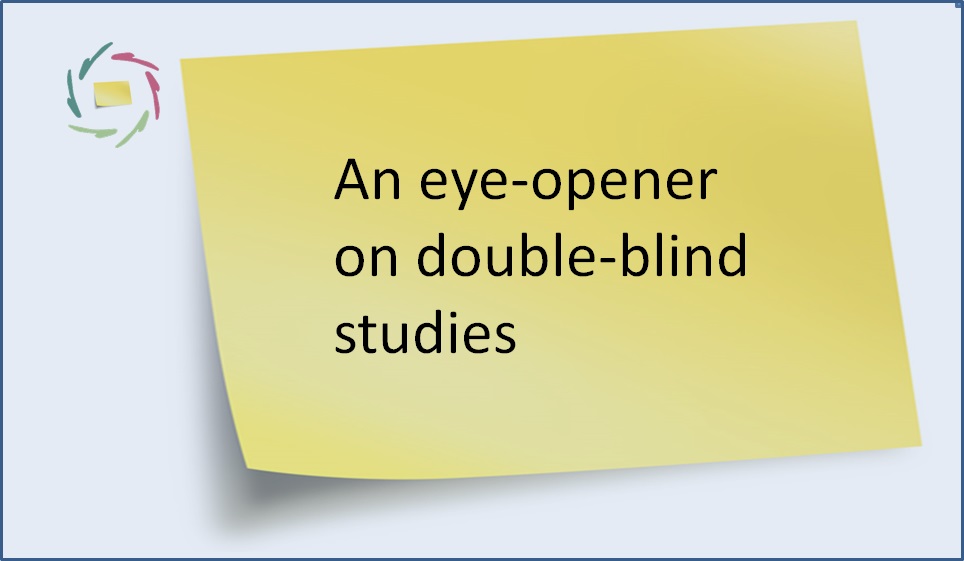

#SINGLE BLIND STUDY FULL#
Single-blind experimental design is used where the experimenters either must know the full facts (for example, when comparing sham to real surgery) and so the experimenters cannot themselves be blind, or where the experimenters will not introduce further bias and so the experimenters need not be blind. In a single-blind experiment, the individual subjects do not know whether they are so-called "test" subjects or members of an " experimental control" group. Single-blind describes experiments where information that could introduce bias or otherwise skew the result is withheld from the participants, but the experimenter will be in full possession of the facts. ĭouble-blind methods came into especial prominence in the mid-20th century. This suggestion contrasted starkly with the prevalent Enlightenment-era attitude that scientific observation can only be objectively valid when undertaken by a well-educated, informed scientist. One of the first essays advocating a blinded approach to experiments in general came from Claude Bernard in the latter half of the 19th century, who recommended splitting any scientific experiment between the theorist who conceives the experiment and a naive (and preferably uneducated) observer who registers the results without foreknowledge of the theory or hypothesis being tested. A well-known violinist played each instrument while the committee listened in the next room to avoid prejudice. In 1817, a committee of scientists and musicians compared a Stradivarius violin to one with a guitar-like design made by the naval engineer François Chanot. īlind experiments went on to be used outside of purely scientific settings. In studying the effects of nitrous oxide (laughing gas) on human physiology, Davy deliberately did not tell his subjects what concentration of the gas they were breathing, or whether they were breathing ordinary air. In 1799 the British chemist Humphry Davy performed another early blind experiment.

These patients showed signs of improved health, but the commission attributed this to the fact that these patients believed they would get better - the first scientific suggestion of the now well-known placebo effect. The commission went on to examine claims involving the curing of "mesmerized" patients. Headed by Benjamin Franklin and Antoine Lavoisier, the commission carried out experiments asking mesmerists to identify objects that had previously been filled with "vital fluid", including trees and flasks of water. The French Academy of Sciences originated the first recorded blind experiments in 1784: the Academy set up a commission to investigate the claims of animal magnetism proposed by Franz Mesmer. (This is commonly the case in ophthalmology, where the word 'blind' is often used in the literal sense.) The terms masked or to mask may be used for the same concept. The terms blind ( adjective) or to blind ( transitive verb) when used in this sense are figurative extensions of the literal idea of blindfolding someone. Although it would be scientifically expedient to raise children under arbitrary experimental conditions, such as on a remote island with a fabricated enculturation, it is obviously a violation of ethics and human rights. An oft-cited example is in the field of developmental psychology. In other disciplines, blind experiments would be very useful, but they are totally impractical or unethical. In some disciplines, such as drug testing, blind experiments are considered essential. Blind experiments are an important tool of the scientific method, in many fields of research- medicine, psychology and the social sciences, natural sciences such as physics and biology, applied sciences such as market research, and many others.
#SINGLE BLIND STUDY TRIAL#
The opposite of a blind trial is an open trial. Similarly, when evaluating the effectiveness of a medical drug, both the patients and the doctors who administer the drug may be kept in the dark about the dosage being applied in each case – to forestall any chance of a placebo effect, observer bias, or conscious deception.īlinding can be imposed on researchers, technicians, subjects, funders, or any combination of them. A blind or blinded experiment is a scientific experiment where some of the people involved are prevented from knowing certain information that might lead to conscious or subconscious bias on their part, thus invalidating the results.įor example, when asking consumers to compare the tastes of different brands of a product, the identities of the product should be concealed – otherwise consumers will generally tend to prefer the brand they are familiar with.


 0 kommentar(er)
0 kommentar(er)
